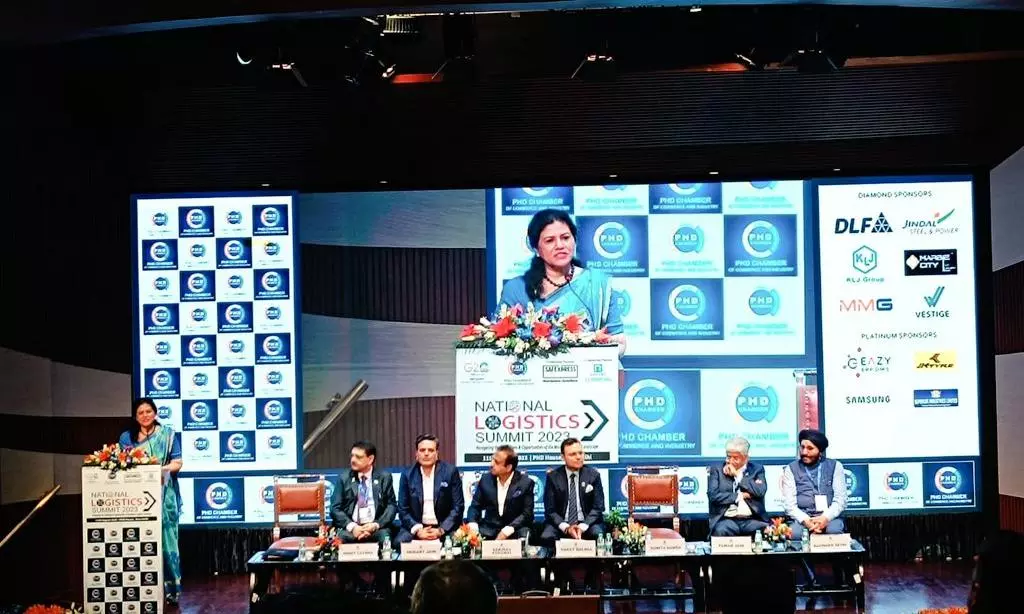PM Gatishakti masterplan a technological miracle: Sumita Dawra
PHDCCI organised the National Logistics Summit on 11th August at the PHD House in New Delhi.

Special secretary- logistics Sumita Dawra described PM Gatishakti masterplan as a technological miracle, emphasizing its utilization of over 450 data layers while explaining how this initiative maximizes connectivity while minimizing ecological impact, effectively supporting sustainable growth.
She was talking at the PHDCCI organised the National Logistics Summit under the theme "Navigating the Challenges & Opportunities of the Modern Logistics Landscape" on 11th August at the PHD House in New Delhi.
Dawra highlighted threefold objectives within the National Logistics Policy. "These goals include achieving international competitiveness by 2030, striving for a position within the top 25 on the Logistic Performance Index, and fostering data-driven decision-making for infrastructure and logistics development."
Dawra also underlined the rapid implementation of the Unified Logistics Interface Platform (ULIP) since the introduction of the National Logistics Policy. "All seven concerned ministries, including the Ministry of Ports, Shipping and Waterways, the Ministry of Civil Aviation, the Ministry of Road Transport and Highways, the Ministry of Commerce and Industry, the Ministry of Railways, the Ministry of Finance, and the Ministry of Electronics and Information Technology, have embraced ULIP with a unified sign-on approach," she said.
Additionally, she elaborated on the Logistics Data Bank, revealing that it currently tracks around 60 million EXIM containers. "This tracking mechanism facilitates valuable insights for speed analysis, benefitting various stakeholders across the logistics chain."
Surendra Ahirwar, joint secretary, logistics, DPIIT underscored that the National Logistics Policy stands as a comprehensive and strategic roadmap. This policy addresses the infrastructure deficit by harnessing digital connectivity, a pivotal focus that is reshaping the logistics landscape.
Ahirwar highlighted the profound impact of the PM Gatishakti Masterplan, describing how it empowers government bodies and administrations to craft infrastructure plans in alignment with national priorities, fostering a seamless and efficient logistics ecosystem.
He called the ULIP as a vital component of the digital framework within the National Logistics Policy. Highlighting its B2B and G2B nature, he emphasized how ULIP seamlessly integrates diverse digital systems from government ministries.
"With diverse systems seamlessly integrated into ULIP's three-tier structure—data layering, administrative, and presentation, the private sector's engagement with the presentation layer offers a unique opportunity for industries to strategically shape their supply chain and logistics operations," he said.
Sanjeev Ranjan, chairman, National Shipping Board, Ministry of Ports, Shipping & Waterways, in his address, highlighted the government's commitment to creating an enabling environment for the logistics sector to flourish and contribute to India's growth story.
Ranjan also appreciated the Carbon Credit Scheme and the new ESG framework. He informed me that there is a new paradigm shift where efficiency has become the focus. The ESG framework and carbon credits, when put together, create opportunities.
Further, in his presentation, he also touched upon the legal and regulatory aspects of these developments and called containerization as a new big thing while highlighting its significance with multimodality.
In his presidential address, Saket Dalmia, president of PHDCCI, expressed that the logistics industry has been significantly impacted by the rapid growth of e-commerce, which has led to an increase in demand for international goods and MSMEs selling internationally.
“The implementation of green logistics technology, which includes climate measurement tools, real-time data-gathering tools, electric vehicles, green cold chain solutions, electric cargo delivery drones, and logistics resource management platforms, can have numerous benefits like reducing waste, simplifying processes, improving a company’s competitiveness, and being environmentally friendly,” added Dalmia.
Mr. Anil Khandelwal, Principal Executive Director, Gati Shakti Railway Board, Ministry of Railways Informed, the Indian economy is experiencing rapid growth, and the demand for logistics is also on the rise. We once held a market share of 85%, but it has gone down to 26%. Accelerating infrastructure development and implementing plans to provide infrastructure ahead of demand is imperative.
The National Logistics Summit underscored the significance of collaboration, innovation, and strategic planning in navigating the evolving logistics landscape. The event provided a platform for industry leaders, policymakers, and experts to exchange insights and discuss the future of logistics in India.




